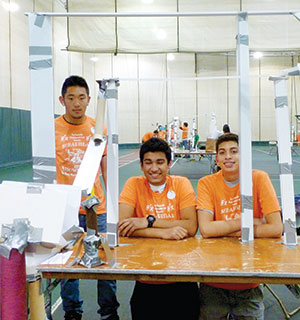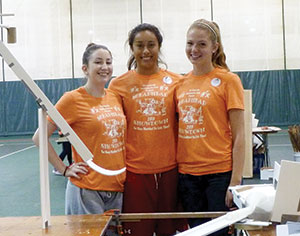
The winning team “Back to Basics” – Elliot Rippe, Arjun Singh, and Daniel Portillo.
By Harry Kane
In an annual event held by the Somerville Mathematics Fund, high school students designed and built marble maze mechanisms out of various “junk” materials to create what’s known as a Rube Golderberg machine. You may recall a famous instance of one of these contraptions in the beginning of the film, Back to the Future. The Rube Goldberg machine achieves a simple undertaking, such as the delivery of a marble, and transforms the process into a complex, over-engineered invention.
But in this marble maze of madness, students were only given a select number of items to use in the building of their contraption. Their materials included pieces of paper, foam core, lots of string and tape.
The savvy students were given their challenge: to design and build a marble maze which would go between the far corners of two side-by-side banquet tables at a rigidly held distance of two feet apart.
The student drops the marble, 4-feet above the table at one end, and the marble makes its way to the finish, explained Erica Voolich, president of the Somerville Mathematics Fund.
On Oct. 20, nine teams comprised of three high school students each, gathered in Gantcher Gym at Tufts University to compete in the ninth annual Scrapheap Showdown.
Students couldn’t simply construct a ramp from one end to the other because that wouldn’t get them any points. The point system gave credit for creativity of designing obstacles and tricks for their marbles’ pathways. The teams worked intensely, building, testing and adjusting their mazes.
If your marble, for example, jumps between tables, you get points for that, explained Voolich. If your marble starts another process or marble going, you get points for that, too. All the various things your marble can do between when you started and when you ended is how you get the extra points. You also get points depending on how long it takes for your marble to get from start to finish.

Third Place team “Mr. Scrima” – Anthony Scrima, R J Bingham, and John Mulcahey
“There wasn’t anything for them to do to prepare,” said Voolich. The kids do not know ahead of time what the challenge is going to be. “Every year we have a scrapheap challenge, and the kids find out about what the challenge is when they arrive.”
Each year the Board of the Somerville Mathematics Fund comes up with a challenge. The Board actually has to try the challenge ahead of time to make sure it works, explained Voolich. “It’s in doing the challenge ourselves each year that we then refine the rules so that we know how to score the various projects.”
The Somerville Mathematics Fund is an affiliate of Dollars for Scholars. They were chartered in 2000 to celebrate and encourage mathematics achievement in Somerville.
A variety of community volunteers sit on the Board of the Somerville Mathematics Fund. The Board consists of a mathematician from Tufts, a former scholarship winner, a college senior at Harvard, an astrophysicist, and a computer scientist just to name a few, explained Voolich. But the main person that spearheads the challenge for the high school kids is Richard Graf, an architect who specializes in repurposing old buildings.
The assembly of the marble mazes took nearly four hours to complete. Each of the nine mazes was remarkable and sported differences in design. Marbles miraculously jumped the tables on what looked like ski runs, or shot out a track and were caught on the other table, went through loop-the-loops, flew through a hoop, zig-zagged back and forth, rode a “cup” elevator up or down, or triggered a mechanism that dropped down, raised up or in some way set off another marble. Some rang bells or started another marble continuing down the track, Voolich said.
Isabel Stevens picked up her son at the end of the day when the teams demonstrated their projects. This is the second year that her son, Ben Stevens, 15, has participated in the mathematics challenge. “Each team is given the same problem to solve, but it’s amazing to watch the different approaches that each team takes, Stevens said. “It’s really wonderful to see all the different solutions that the kids come up with.”
Stevens said that her son likes the real world application of the math concepts. The highlight for the sophomore student is at the end of the day, when he finally gets to try out what was built and see how it works.
The team with the highest overall score, was “Back to Basics” (Elliot Rippe, Arjun Singh, Daniel Portillo). Second place was the “Swerve” (Caterina MacDonald, Melissa Baptista, Rachel Berry). Third place was “Mr. Scrima” (Anthony Scrima, R J Bingham, John Mulcahey). Fourth place was “Junk Punks” (Kelly Cachimuel, Ben Stevens).
“It was a fine day and the kids were really intently involved in it,” Voolich said. The Somerville Mathematics Board has challenged the students every year for almost a decade, from making windmills to creating cantilevers out of paper. “There’s been a variety of things that we’ve asked kids to do, and they rise to the challenge.”
*













Reader Comments